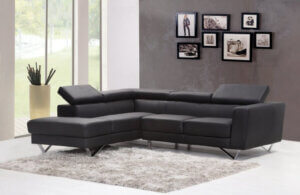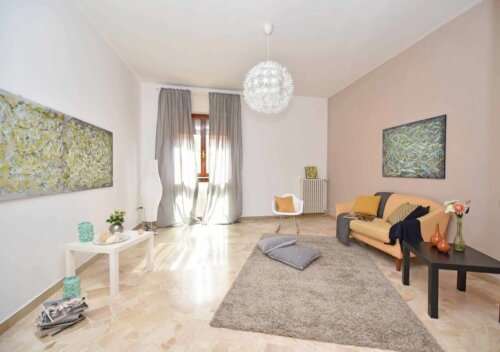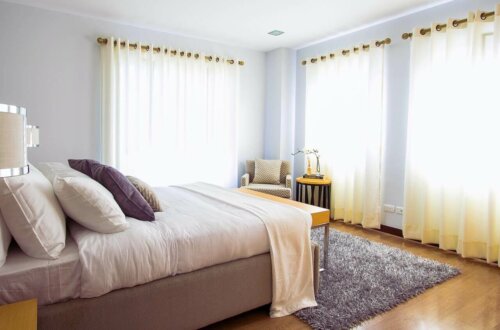Different Textures for Rugs

When it comes to decoration, you shouldn’t limit yourself to only considering colors and shapes. Textures are also very important! Let’s take a closer look at different textures for rugs and all of your options.
First, let’s consider all the different choices on the market. However, ultimately, your selection will depend on your tastes. Often, we choose based on appearance rather than for the feeling of the piece.
As a result, it’s important that you make sure you like the material of the product before buying it. Touch is an important sense that can help you figure out what you want. Also, remember that you’re going to constantly feel your rug with your feet!
Textures for rugs – traditional rugs

Generally, there are traditional rugs in homes that have a comfortable, padded texture. They’re not overly soft, but they do have a velvety quality that feels nice.
Basically, this style is resistant over time. It’s great for rooms such as the entryway, hallways, and the living room or, in other words, places where there is lots of daily use.
Of course, you can always use these rugs in the bedroom. In fact, these work in any space of the house. Some examples are Kilim or Persian rugs, which stand out more for their patterns than their texture.
A traditional element that reminds us of the past and has become vintage.
Textures for rugs – the softest rugs
When it comes to textures for rugs, people usually choose rugs that turn out to be softer. There are different types and some are truly soft, so much so that you can sit on them. Let’s look at some examples:
- For the foot of the bed, it’s best to use one of the most comfortable rugs that are pleasant to the touch and help create a feeling of serenity and calmness. These are usually made of polyester or cotton. In addition, they are easy to clean.
- There are also shaggy rugs for winter that keep your feet warm. These give off the same feeling as if you’re petting an animal. While these rugs are usually monochromatic, there are also some with patterns.
- Another option is vinyl rugs. These don’t have a texture like the other ones, but they are practical, functional, and simple. This is a great option for the living room, entrance, or bedroom and adapts well to any floor.
- Also, you can always opt for a long hair rug. These are like shaggy rugs but taller so they are also striking due to their shape. This type of rug is inviting to step on because of how soft they are.
- For children’s rooms, lamb velvet ones are good choices. Little ones can play on them and they hold up well over time.

Jute rugs – strength and toughness
Contrasting with the previous rugs we’ve seen are jute rugs. This material is stronger and more durable. They are appropriate for living rooms, dining rooms, or areas where there’s more activity.
The texture of these rugs is somewhat rougher and more rigid. They go great with a country or rustic style home, especially with stone floors, as they give a vintage touch.
So where to put them? These look great at the entrance of the house not just because this is a place with lots of activity, but also because of the visual effect of a functional, durable component.
Textures of rugs – PVC rugs for practicality and lightness
Among textures of rugs, we should take into account that we’re looking for a practical, lightweight format. Nowadays on the market, you can find ones made of PVC, which is a new, exciting material.
So what are these really like? They are lightweight and practical, in addition to having lots of patterns and colors. They are also perfect for modern floors.
However, the texture of these rugs is very basic. They are very durable and don’t deteriorate easily, but they are also soft to the touch.
When it comes to decoration, you shouldn’t limit yourself to only considering colors and shapes. Textures are also very important! Let’s take a closer look at different textures for rugs and all of your options.
First, let’s consider all the different choices on the market. However, ultimately, your selection will depend on your tastes. Often, we choose based on appearance rather than for the feeling of the piece.
As a result, it’s important that you make sure you like the material of the product before buying it. Touch is an important sense that can help you figure out what you want. Also, remember that you’re going to constantly feel your rug with your feet!
Textures for rugs – traditional rugs

Generally, there are traditional rugs in homes that have a comfortable, padded texture. They’re not overly soft, but they do have a velvety quality that feels nice.
Basically, this style is resistant over time. It’s great for rooms such as the entryway, hallways, and the living room or, in other words, places where there is lots of daily use.
Of course, you can always use these rugs in the bedroom. In fact, these work in any space of the house. Some examples are Kilim or Persian rugs, which stand out more for their patterns than their texture.
A traditional element that reminds us of the past and has become vintage.
Textures for rugs – the softest rugs
When it comes to textures for rugs, people usually choose rugs that turn out to be softer. There are different types and some are truly soft, so much so that you can sit on them. Let’s look at some examples:
- For the foot of the bed, it’s best to use one of the most comfortable rugs that are pleasant to the touch and help create a feeling of serenity and calmness. These are usually made of polyester or cotton. In addition, they are easy to clean.
- There are also shaggy rugs for winter that keep your feet warm. These give off the same feeling as if you’re petting an animal. While these rugs are usually monochromatic, there are also some with patterns.
- Another option is vinyl rugs. These don’t have a texture like the other ones, but they are practical, functional, and simple. This is a great option for the living room, entrance, or bedroom and adapts well to any floor.
- Also, you can always opt for a long hair rug. These are like shaggy rugs but taller so they are also striking due to their shape. This type of rug is inviting to step on because of how soft they are.
- For children’s rooms, lamb velvet ones are good choices. Little ones can play on them and they hold up well over time.

Jute rugs – strength and toughness
Contrasting with the previous rugs we’ve seen are jute rugs. This material is stronger and more durable. They are appropriate for living rooms, dining rooms, or areas where there’s more activity.
The texture of these rugs is somewhat rougher and more rigid. They go great with a country or rustic style home, especially with stone floors, as they give a vintage touch.
So where to put them? These look great at the entrance of the house not just because this is a place with lots of activity, but also because of the visual effect of a functional, durable component.
Textures of rugs – PVC rugs for practicality and lightness
Among textures of rugs, we should take into account that we’re looking for a practical, lightweight format. Nowadays on the market, you can find ones made of PVC, which is a new, exciting material.
So what are these really like? They are lightweight and practical, in addition to having lots of patterns and colors. They are also perfect for modern floors.
However, the texture of these rugs is very basic. They are very durable and don’t deteriorate easily, but they are also soft to the touch.
All cited sources were thoroughly reviewed by our team to ensure their quality, reliability, currency, and validity. The bibliography of this article was considered reliable and of academic or scientific accuracy.
- Gilliat, Mary: El libro de la decoración, Folio, 1986.







